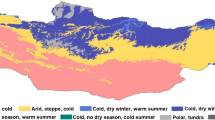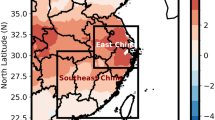Abstract
Landscape characteristics influence meteorological factors, thus affect the occurrence and nature of dust storm events. The present study investigates the spatiotemporal characteristics of six meteorological factors (wind velocity, wind direction, air temperature, relative humidity (RH), photo synthetically active radiation (PAR), and solar radiation) over different landscape types (shifting-sand frontier, semi-fixed sandy land, fixed sandy land, and the inner region of an oasis) before and after dust storms during four typical dust storm events in an oasis-desert ecotone in Cele, Xinjiang, China. The results show that the average wind velocity decreased significantly from the shifting-sand frontier to the inner oasis, which was mainly attributable to the vegetation coverage. Before the dust storm events, there were obvious differences in air temperature and RH either in the horizontal or vertical direction over the different landscape types. However, these factors were very similar during and following the dust storm events. PAR and solar radiation were significantly reduced during the dust storm events and the subsequent sand-blowing and floating-dust conditions. This effect was much stronger than during similar weather conditions without dust storm events such as sand-blowing and overcast and/or rainy days. Additionally, the variation in the meteorological factors among the different landscapes was also affected by the prevailing wind direction during the dust storm events. However, the landscape type slightly changed the prevailing wind direction, with the greatest dispersion distribution of wind direction in the inner oasis. The findings of this study are helpful for understanding the function of landscape types in the occurrence of dust storms, as well as for providing a theoretical basis for prevention of dust storms.
Similar content being viewed by others
References
Bai Yungang, Song Yudong, Zhang Jianjun, et al., 2005: Spatialtemporal distribution of sandstorm weather trend in Tarim basin in recent 40 years. J. Arid Land Resour. Environ., 19, 42–45. (in Chinese)
Central Meteorological Bureau, 1979: Specification for Ground Meteorological Observation. China Meteorological Press, Beijing, 21–27. (in Chinese)
Chen Weinan, Dong Zhaibao, Yang Zuotao, et al., 1995: Threshold velocities of sand-driving wind in the Taklimakan desert. Acta Geographica Sinica, 50, 360–367. (in Chinese)
Chen Zhigang and Zhou Jianhua, 2010: NDVI and the conditions of generating sandstorm. Ecology Environ. Sci., 19, 870–876. (in Chinese)
Desouza, N. D., B. Simon, and S. M. Qureshi, 2011: Evolutionary characteristics of a dust storm over Oman on 2 February 2008. Meteor. Atmos. Phys., 114, 107–121.
Fan Da, Shi Peijun, and Liu Sanchao, 2010: Relationship between dust storm disaster and vegetation fraction in northern China. J. Nat. Disasters, 19, 1–7. (in Chinese)
Feng Qi, Si Jianhua, Zhang Yanwu, et al., 2006: Microclimatic characteristics of the Heihe oasis in the hyperarid zone. J. Geograph. Sci., 16, 33–44. (in Chinese)
—, Zhou Macuo, and Xi Haiyang, 2009: Analysis of an oasis microclimate in China’s hyperarid zone. Environ. Geol., 58, 963–972.
Goudie, A. S., and N. J. Middleton, 1992: The changing frequency of dust storms through time. Climate Change, 20, 197–225.
Hai Xianlian, 2011: Contrast analysis of surface meteorological element during twice powerful sandstorm processes in 2010. J. Arid Land Resour. Environ., 25, 104–108. (in Chinese)
Hamidi, M., M. R. Kavianpour, and Y. P. Shao, 2013: Synoptic analysis of dust storms in the Middle East. Asia-Pacific J. Atmos. Sci., 49, 279–286.
Joseph, P. V., D. K. Raipal, and S. N. Deka, 1980: “Andhi”, the convective dust storms of Northwest India. Mausam, 31, 431–442.
Li Xiangyu, He Qing, Huang Shaopeng, et al., 2009: Characteristics of meteorological factors in the surface layer before and after a severe sandstorm in the Taklimakan desert hinterland, southern Xinjiang, China. Plateau Meteor., 28, 652–662. (in Chinese)
Lin Yuquan, 1988: The flow field characteristics and its relation to the intensity of drifting sand activity in Taklimakan desert. J. Desert Res., 8, 25–37. (in Chinese)
Liu Haitao, Zhang Xiangjun, Li Yingkui, et al., 2009: The time-space distribution characteristics of sand storm weather in Hotan region. J. Arid Land Resour. Environ., 23, 85–89. (in Chinese)
Liu Jingtao, Qian Zhengan, Jiang Xuegong, et al., 2004: A study on weather types of super severe dust storms in North China. Plateau Meteor., 23, 540–547. (in Chinese)
Lu Zheng and Liu Couhua, 2006: On the relationship between sandstorm and meteorological factors in China. Meteor. Mon., 32, 35–41. (in Chinese)
McTainsh, G. H., A. W. Lynch, and E. K. Tews, 1998: Climatic controls upon dust storm occurrence in eastern Australia. J. Arid Environ., 39, 457–466.
Muhammad, A., T. R. Sheltami, and H. T. Mouftah, 2012: A review of techniques and technologies for sand and dust storm detection. Rev. Environ. Sci. Biotechnol., 11, 305–322.
Niu Shengjie, Yue Ping, and Liu Xiaoyun, 2007: Variations of surface meteorological element during twice dust storms passing Jiuquan on 28 March and 12 July 2004. J. Desert Res., 27, 1067–1071. (in Chinese)
Qian Yibing, Wu Zhaoning, Zhang Liyun, et al., 2004: Ground-surface conditions resulting in dust storms in the south Junggar basin. Arid Land Geography, 27, 540–542. (in Chinese)
Qian Zhengan, Cai Ying, Liu Jingtao, et al., 2003: Some progresses and problems in research of dust storms in northern China. Annual Conference of Chinese Meteorological Society in December 2002, Chinese Meteorological Society, Beijing, 254–258. (in Chinese)
Taha, H., H. Akbari, and A. Rosenfeld, 1991: Heat island and oasis effects of vegetative canopies: Micrometeorological field-measurements. Theor. Appl. Climatol., 44, 123–138.
Wang Shigong, Dong Guangrong, Chen Huizhong, et al., 2000: Advances in studying sand-dust storms of China. J. Desert Res., 20, 349–356. (in Chinese)
Wang Xu, Ma Yu, and Chen Hongwu, 2003: Climate characteristics of sandstorm in Xinjiang. J. Desert Res., 23, 539–544. (in Chinese)
Yang Xinhua, He Qing, Huo Wen, et al., 2012: Sand saltation in the southern margin of the Taklamakan desert-A case study on Cele County. J. Desert Res., 32, 910–914. (in Chinese)
Yang Zuotao, 1990: Relationship of wind direction and wind velocity between the Gobi desert and oasis: A case study on Cele County in Xinjiang. J. Desert Res., 10, 33–39. (in Chinese)
Yao Jimin, Gao Xiaoqing, Feng Qi, et al., 2006: The photosynthetically active radiation during dust storm day in Ejina oasis. Acta Energiae Solaris Sinica, 27, 484–488. (in Chinese)
Zhang Henian, 1995: Research of synthetic renovation technology and experiment demonstration in ecological environmental area in ecotone in the south of Taklamakan. Arid Zone Res., 12, 1–9. (in Chinese)
Zhang Tairen, Chai Xiumei, and Li Zizhen, 2010: Characteristics of vegetation coverage in northern China and its relationship with sandstorm. Plateau Meteor., 29, 137–145. (in Chinese)
Zhou Zijiang, Wang Xiwen, and Niu Ruoyun, 2002: Climate characteristics of sandstorm in China in recent 47 years. J. Appl. Meteor. Sci., 13, 193–200. (in Chinese)
Zu Ruiping, Zhang Kecun, Qu Jianjun, et al., 2005: Characteristics of surface winds in Taklimakan deserts and their relationship to the orientation of dunes in neighboring regions. J. Appl. Meteor. Sci., 16, 468–475. (in Chinese)
Author information
Authors and Affiliations
Corresponding author
Additional information
Supported by the Special Major Science and Technology Projects in Xinjiang Uygur Autonomous Region (201130106-1), China Meteorological Administration Special Public Welfare Research Fund (GYHY201106025), Xinjiang Normal University Doctor of Geography Supporting Program, and Xinjiang Lake Environment and Resources Laboratory of Arid Zone (XJDX0909-2013-08).
Rights and permissions
About this article
Cite this article
Mao, D., Lei, J., Li, S. et al. Characteristics of meteorological factors over different landscape types during dust storm events in Cele, Xinjiang, China. J Meteorol Res 28, 576–591 (2014). https://doi.org/10.1007/s13351-014-3097-4
Received:
Accepted:
Published:
Issue Date:
DOI: https://doi.org/10.1007/s13351-014-3097-4




